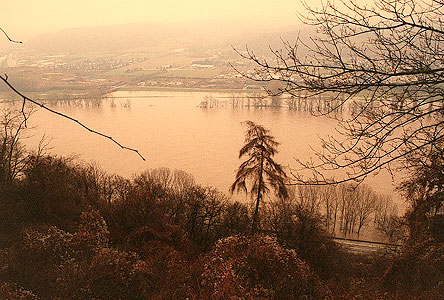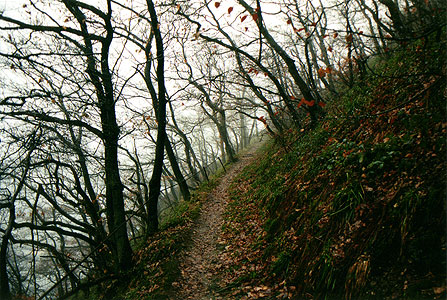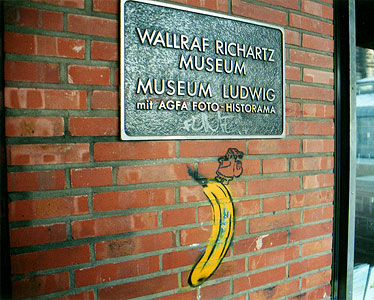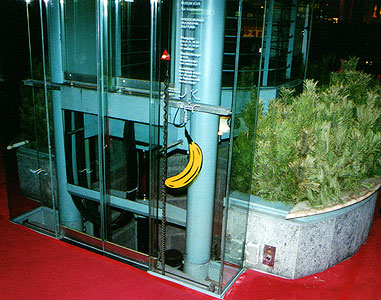These bananas appeared in the strangest places: by the front door of the Ludwig Museum, on an elevator near a bookstore, on the door to an art-house movie theatre in Bonn, on the wall of a bank. They appeared with no explanations and rarely did they appear marred or tampered. Were they the guideposts to a tour of Köln and Bonn? Were they someone's sign of endorsement? Were they just there to make people smile?

Sub-freezing temperatures have a tendency to encourage one to stay indoors, next to a heater, swaddled in three or four blankets, drinking something either hot or spiked or both. I worried that perhaps we were not active enough, but after walking by the Rhein at dawn once or twice, sniffling and unable to feel my fingers, I began to think that waiting for spring might be the thing to do. The sun rise was beautiful; staying warm was even better.

When the snow in Switzerland begins to melt, the Rhein in Germany starts to flood. Here the waterlevel is at least 20 feet above normal, submerging trees and flooding fields. In Bad Breisig there is a strip of riverfront restaurants and hotels, each with pictures of floodwaters up to their awnings. The older buildings have small plaques marching up their sides, marking the high water levels back to the 1600s. Some years the water reaches into the second floors of these buildings, and still the businesses thrive. In flood season, they close up shop, move the furniture, and pile sandbags in front of the door; when the waters recede, the people return, clean up the mud, put out the tables and invite you in for a beer.
The winter of 2000 was not a landmark year in the flood department. Still, I was impressed. Although I'm not sure which is more impressive, the immense personality of the river or the stubbornness of the people and businesses on its banks.

Public walking trails wound around our castle-topped hill and through the surrounding woods. On days when the temperature got above freezing Ian and I would go for walks, criss-crossing the hills and the fields behind the Rheineck. We found a tennis and recreation park closed for the winter, the remains of some logging operation, hunting blinds, the road to Waldorf, a cow or two, the road to Brohl and a shrine to the Virgin. Occasionally, we'd encounter other people; most were joggers but once we met a group of women in their Sunday clothes and dress shoes walking up a neglected and muddy trail from the shrine. On days when the clouds thinned a little and the sun poured its light on the winter earth, I swore I could see God.

Little bits of green in an otherwise bleak winter-shrouded world. The sky was nearly always gray, the trees nearly completely devoid of leaves, the wet ground covered with the faded colors of fall. But if there was green here, perhaps we would see Spring return someday.
|




